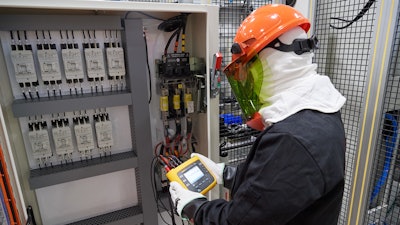
Companies are missing out on this opportunity to lower their energy costs and it really couldn’t be simpler. Poor power quality issues cost U.S. companies an estimated $119 to $188 billion annually, according to the Electric Power Research Institute (EPRI). Monitoring and analyzing power quality for three different variables found on a utility bill can help drop energy costs, save wear on equipment and reduce downtime—all with only two types of tools. 
Collect Critical Data
The first tool needed gathers the data on energy flows and activity over time. Attached to different loads and circuits, such as boilers, chillers, furnaces and conveyor systems, energy loggers constantly gather information. By themselves, loggers can be used to verify electrical system capacity before adding loads or to perform energy assessments to quantify energy consumption before and after improvements, not only identifying but also justifying energy-saving expenditures.
The Fluke 1738 Advanced Three-Phase Power Logger works well in these capacities. With its ability to automatically capture and log extensive power quality parameters, it gives electricians and technicians more visibility into the data needed to make better power quality and energy consumption decisions.
Analyze the Data
Though the logger itself creates value, when combined with analyzation software, that energy data can be assessed for power quality issues and areas of waste can be identified, along with facility-wide waste patterns. Technicians can leverage their understanding of the equipment and processes to make waste identification that much easier.
Visualization of the data gathered by the loggers speeds and simplifies assessment. For example, the Fluke Energy Analyze Plus software package quickly and easily graphs measurements from the loggers to help identify issues and create detailed reports. Trend graphs over time can reveal anomalies, while the calendar view displaying graphs can show energy consumption against activity in a circuit in a part of the plant to signal needed investigations into whether the cause is impending equipment failure or the equipment is operating consuming energy unnecessarily. 
Knowing the needs of equipment at varying times of day also creates planning opportunities to take advantage of the utility company’s lowest rates and to avoid penalties.
1. Managing to Avoid Peak Hour Penalties
During peak hours, exceeding the allotted power usage could increase energy costs 10 to 100 times. Utilities strictly monitor for these excesses because of the potential shutdowns if the demand exceeds their capacity.
The fix is easy. Once technicians can see the data showing exactly where and how much power is being used in the facility, they can make workflow adjustments to alleviate the chance of the sum total exceeding the utility’s maximum level set for those peak hours.
With the data provided by the Fluke 1730 series loggers to the Energy Analyze Plus software, it can display the peak demand session for the plant and how much the load for each piece of equipment contributes to that demand.
That information allows facility managers to assess which machines may need to be turned off, setpoints adjusted, or put in rotation during the utility’s peak rate period to accommodate the high-usage equipment in the plant and avoid the excessive penalties for over-usage. For instance, it may become clear that the HVAC heating/cooling setpoints need to be adjusted when using certain processors in parallel at peak hours.
2. Spotting Leaks
By placing loggers throughout the facility to map out the usage of energy, including at the service entrance, a company can measure how efficiently energy is being consumed. Using the electrical blueprint to compare consumption data of machines collected by the loggers, then correlating that usage with the utility bill and operating processes can reveal where electricity spikes do not match the expected work effort from that machine or circuit. Those anomalies unveil potential leaks which lower power quality drive up utility costs. Identifying and fixing these wasted resources minimizes penalties and surcharges to achieve sustainable operating expense savings.
3. Influencing the Power Factor
A commonly ignored statistic on a company’s utility bill, the power factor (the ratio of usable real power to apparent power) shows the efficiency of power usage by a facility. A 100%-efficient usage shows as 1.0 on the bill. In the U.S., a company with less than .85 to .95 power factor may generate penalties depending on the utility. Various sources of power quality disturbances that impact that ratio, though, can be identified.
Power quality issues affect equipment performance and efficiency. Voltage and frequency irregularities, like harmonic distortion, which is similar to a screaming baby at a concert, produce waste. That imperfection impacts power quality and contributes to machine stresses, which result in downtime and potential penalties from the utility company.
The Power Quality Health Summary on the Fluke Energy Analyze Plus software package can identify these types of voltage variances without having to be an expert. The software monitors for dips and swells in energy flow that cause lights to flicker, along with false resets or nuisance circuit-breaker trips, hampering productivity.
These types of PQ issues can particularly harm sensitive electronics, especially transients, where lightning or the switching of heavy loads generates arcs across contactors as the load is energized. Transient voltages can impact unprotected sensitive equipment as they dissipate through the system, leading to random malfunctions or permanent failure.
Voltage unbalance across the three conductors in a system can also be harmful. If one phase is pulling more power than the other two, too little power may be delivered to the machines reliant on the weaker strands, causing spontaneous shut downs or failures.
If the line voltage frequency deviates from the standard generator frequency, it can impact the efficiency of inductive loads by potentially increasing the inductive or capacitive reactance and therefore power factor and harmonic distortion. In some cases, frequency variations can trigger control responses in systems with uninterruptable power or backup generators, leading to disruptions.
Though power quality issues could stem from within the facility or even from neighbors, some power quality problems can originate from the utility. Placing a power quality logger on the circuit where energy enters the facility, companies will have the data to investigate internal issues further or support their claim that subpar power is being delivered to their building.
The PQ Health Summary feature takes this power quality assessment a step further. By gathering data over an extended period at the service entrance or downstream at the load, it looks at energy consumption from a qualitative standpoint, and compares critical power quality characteristics to industry norm standards for healthy power. It is based on detailed power quality data including viewable event waveform captures for even more visibility into the data needed to optimize system reliability and savings.
With those insights into the voltage variances and continued logger trend data being analyzed by the Energy Analyze Plus software, a company can determine whether a power quality problem exists, know if the fix has made enough of a difference to affect their utility bill, and ultimately maintain lower electric costs, avoid penalties, and reduce risk of downtime.
About the Author
Hilton Hammond, Product Manager Fluke Analysis and Diagnostic Tools
Educated at Technical College of Johannesburg in South Africa with 30 plus years of experience in the electronics test and measurement industry as a technician, metrologist, technical application specialist and product innovation manager. Along with industry experts, Hilton has led the development of several comprehensive electrical and electronic test programs and applications on motors and drives, industrial networks and automated production test system applications. Hilton received an award from The Journal a Rockwell Automation publication for Publication Excellence on the topic of How to Measure Output Voltage from a VFD. Hilton’s passion is to help end users solve tough industrial equipment performance and maintenance problems with the aim of improving uptime and end users test and measurement knowledge. He is currently working on new products that further simplify troubleshooting industrial systems. You can reach Hilton at [email protected]





















